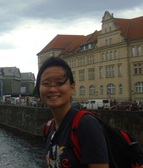Week 4: The story of Duisburgby Pin-Wen Wang When I found out that I would be spending my summer in Duisburg, I honestly had to look up where Duisburg was. I didn’t even know in what region of Germanyit was in. In the industrial age, Duisburg was an important harbor port for Germany and was home to the country’s most important steel and coal industries. Because of this, during World War II, the region was severely bombed. From stories I’ve heard, it is my understanding that the population of Duisburg literally disappeared for some time after the war. Even today, this area is struggling with its economy. At night, Duisburg feels a bit like a ghost town; the streets are empty and dark, but oddly enough, it still feels safe, really safe. I’ve visited many other cities in the region, including Dusseldorf, Cologne, Bonn, and Aachen, but none of them have the same feeling as Duisburg. Duisburg really is an industrial region, much like the rust belt of the states, if you will. I’ve never been to a place like Duisburg before, and it has really opened my eyes to the world. I was blown away the first time I walked along the waters and saw a cargo ship yard with colorful crates stacked high over the trees and huge flat ships carrying piles of black coal drifting down the water. Many of the attractions here are based around this industrial history. Landschaftspark, the most popular attraction in Duisburg, is quite literally an old steel factory where you can climb the magnificent steel structures for a view of the city. Also, steel sculptures are built on man-made mountains of coal waste—a tribute to the steel and coal industry of the region. A few weekends ago, one of my co-workers from lab took us to one of these man-made mountains. As you circle up to the top of the mountain, you can pick up small pieces of coal that stain your fingers. Luckily, nature has taken over, and the mountain is filled with trees and bushes; the trek up the mountain feels more like a short hiking trip. and it’s a great feeling to get away from concrete roads and buildings. Reaching the top of these mountains is probably one of the weirdest feelings I’ve ever had. The view is breathtakingly gorgeous, but the view isn’t of natural mountains, forests, or waters. Instead, the view is of a quiet city and of one of the last running coal factories of the region. I could see a fire burning in the distance and long red pipes stretching toward the sky. In between it all, there were houses, small homes lining the valley. The view sent chills down my spine—a reminder of what humans were doing to the natural environment. There isn’t all that much to do in a city like Duisburg, but there are the simple joys of walking around town, especially on the main pedestrian walking street in the center of town, which is complete with great bakeries, ice cream shops, and back to back malls. On weekends, I’m traveling all over the place. I bought a Europass that lets me take the fast trains anywhere in Germany or to the Benelux countries, so most weekends I’m riding the train all over Germany. With my student ID card, I can also take any regional train in my state, so I’ve been to many of the cities here including Bonn (known for being the birthplace of Beethoven), Aachen (known for being Charlemagne’s preferred residence and for its natural healing spas), and most notably, to Cologne to see one of Germany’s main attraction: the Cologne Cathedral. When everything but cafes and restaurants are closed on Sundays, the city really comes alive. Families, friends, and old couples walk the promenade along the Rhine River and window shop different stores in the city. I used to think that Sundays were slightly boring because nothing was open, but I’ve learned from the locals to cherish Sundays. I’ve learned the true value of window shopping, relaxing over a drink, and taking time to really reflect on the week… and also to write this blog! About the Blogger
0 Comments
Your comment will be posted after it is approved.
Leave a Reply. |
The Lab JournalWelcome to the summer internship series of 2012! Follow 9 Scientista bloggers through their summer internships to catch a glimpse of what it is like to be a scientista^TM. By Title- India Presents: A "New World Symphony"
- Through The Lens: The Intricacies Of Diabetes - Do Nanoparticles Glow? - Using Unusual Animals to Study Human Disease - Using the Hubble Telescope - You Think What You Eat - Experimenting With the Life of a Scientist(a) - 18.085: My Summer at MIT - Science Heals: A Summer of Global Health Research By BloggerRabeea Ahmed
Riana Balahadia Shaira Bhanji Nzuekoh Nchinda Amy Beth Prager Natalie Punt Juliet Snyder Pin-Wen Wang Stephanie Wang Archives |
The Scientista Foundation, Inc. All Rights Reserved © 2011-2021 | Based in NY | contact@scientistafoundation.org
The Network for Pre-Professional Women in Science and Engineering
The Scientista Foundation is a registered 501(c)(3) -- Donate!
The Network for Pre-Professional Women in Science and Engineering
The Scientista Foundation is a registered 501(c)(3) -- Donate!


 RSS Feed
RSS Feed